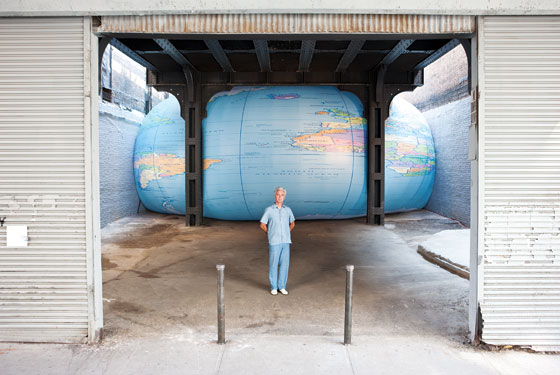
Global Inflation:Under the High Line, David Byrne Blows Up the World
By Rachel Wolff, New York Magazine, 11 September 2011 [Link]

Danny Kim
Starting on the evening of September 15, you�ll hear it as you approach West 25th Street, coming from under the High Line: womp, womp womp. It�s a little bit fore�boding�the sort of low-�frequency pulsations that signal zombies in movies and sent Jodie Foster alien-hunting in Contact. It plays on a loop, intercut with other baritone noises. It�s not a soundtrack that�s characteristic of the galleries, car-repair shops, and luxury condos of West Chelsea (though there are lots of subwoofer-equipped nightclubs nearby). It�s certainly not the polyethnic pop we have come to expect from David Byrne.
As it happens, the long-ago Talking Head is the man behind the rumbles, and behind their source, which you see once you turn the corner onto 25th Street: It comes from speakers inside a 48-by-20-foot inflatable globe, pumped up against the High Line�s steel framework, like an exercise ball smushed under a coffee table. Peru bulges against the eastern wall; the Arctic and Antarctica peer around the edges; Algeria and Mauritania swell near the beltline. The installation is called Tight Spot, and it�s up for two weeks courtesy of the Pace Gallery.
And here comes Byrne himself, arriving as usual by bicycle, dressed all in blue, accented by his white hair, white wristwatch, and white leather sandals. He matches the oceans and ice caps, though he insists it�s a coincidence. �It�s big, isn�t it? It has some real mass to it,� he says, pressing on the South Atlantic with both hands and considerable force. The globe has just been inflated for the first time, and he�s happy with the result, which is different from the small models and renderings he�d sent off to the fabricators in Minneapolis. �It kind of looms over you. You don�t get that from the drawing.� (Byrne�s work will also be included in the Pace group show �Social Media,� where his contribution is a series of ads for mock iPhone apps that purport to add snark to your writing, to auto-reply to unwanted e-mails, to babysit your kids.)
Byrne says he exulted in the project�s limits. �The worst is to be told, Oh, just do anything you want to do,� he says. �Things tend to create themselves when you lay out all the rules.� He certainly had a restriction: the site itself, a dark and grimy plot that, Byrne says, had been �a dumping ground for car parts and junk.� The piece needed to withstand the weather; it needed to interact with the High Line; it needed to stand out from its surroundings; it needed to entice passersby; it needed to be temporary (and thus somewhat inexpensive); and it needed to be relatively PG.
Once he laid out these considerations, the shape and subject came to him almost immediately, he says, and he gravitated (so to speak) toward something more like a grade-school artifact, with pastel colors and clean lines, than a precise model via Google Earth. �I wanted to go for the graceful vision, the world I knew from childhood�I used to have globes in my house that looked just like this. It�s a little lighter and a little more fun. But there is a bit of an ominous message as well.� An ecocrisis interpretation is more or less inevitable (a pale-blue planet swelling under pressure).
Byrne also evokes a peaceful nostalgia. After all, on a classroom globe, you know where everyone�s borders and national identities are, and they don�t appear to change from day to day. As for the audio component�that dark and portentous pulse�it mates well with the High Line, a sound both natural and industrial, like �a giant piece of fabric or a sail, and the wind beating against it. Or a big piece of machinery in a building that is far enough away so that you can�t totally hear it, but there is that one part of the sound that really travels,� Byrne says. It turns out that he sang it himself. �Rather than try to get it electronically or find instruments to do it, I just made the sounds with my mouth and filtered them enough so that you can�t tell it�s a human voice.�
Tight Spot is the only work of art that will ever occupy this spot, which, Byrne notes, �wasn�t quite claimed by anybody for a long time.� After October 1, Pace�s new gallery�its fifth in the city�will be built here. Pace�s president, Marc Glimcher, says that the site restrictions were almost as daunting to him as to Byrne. �It�s the same thing,� he says. �You have to squish a gallery in there, too.�

